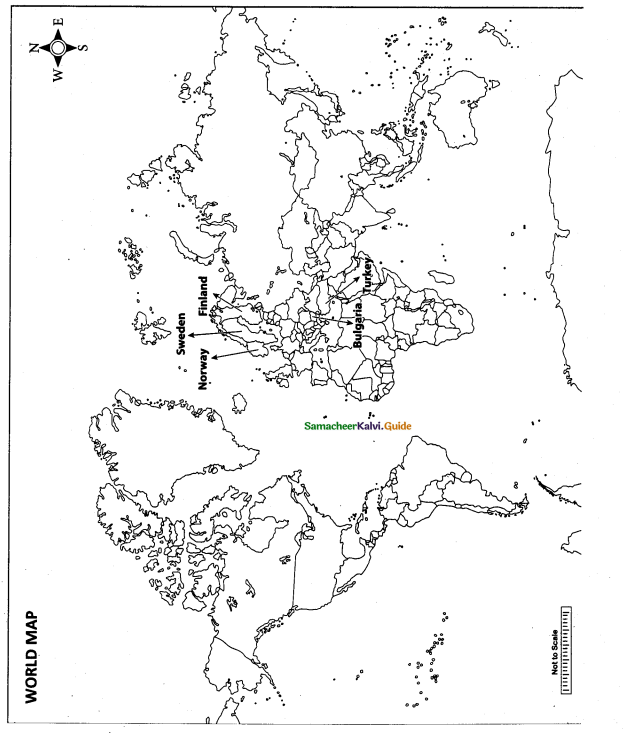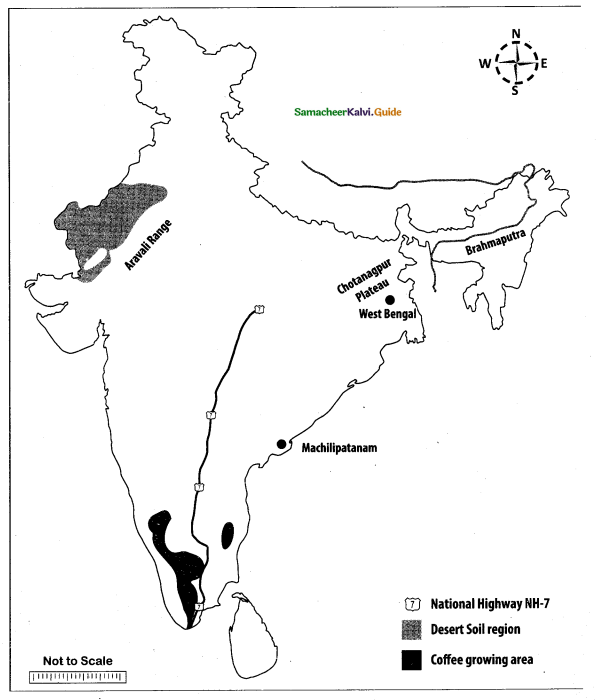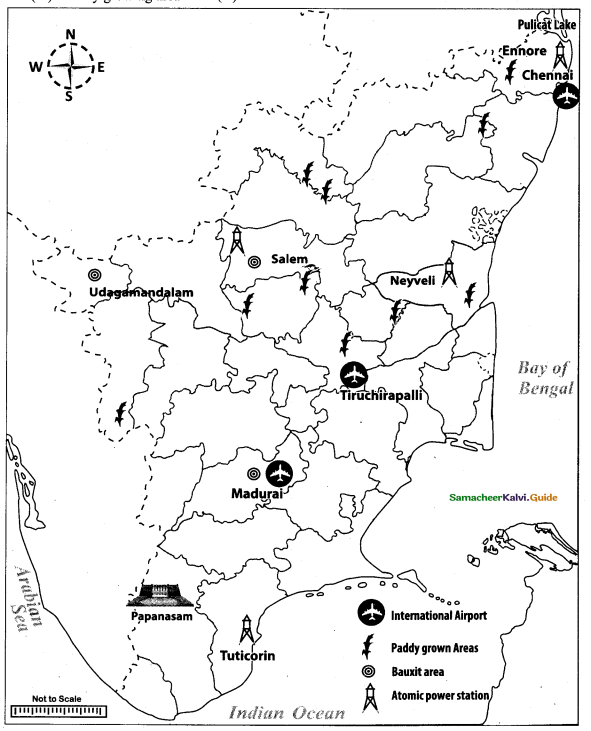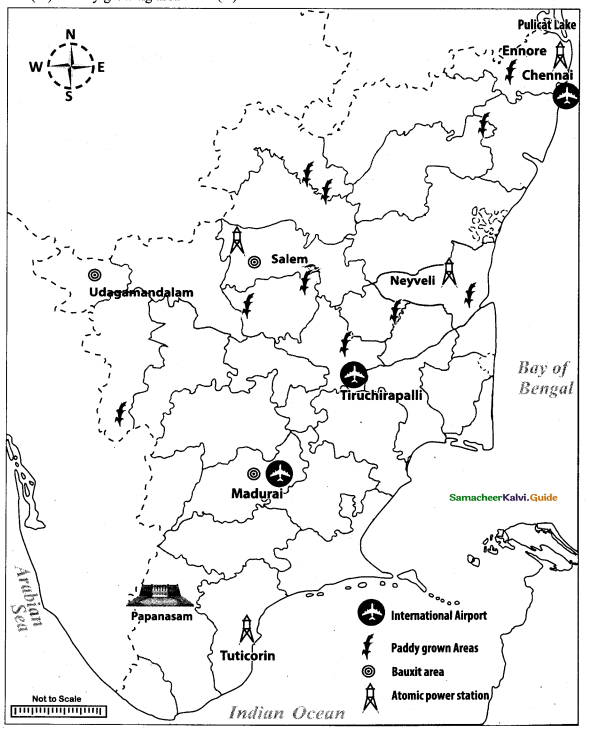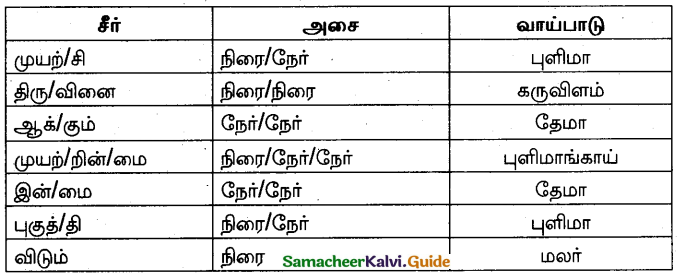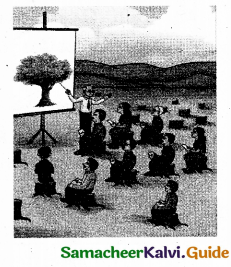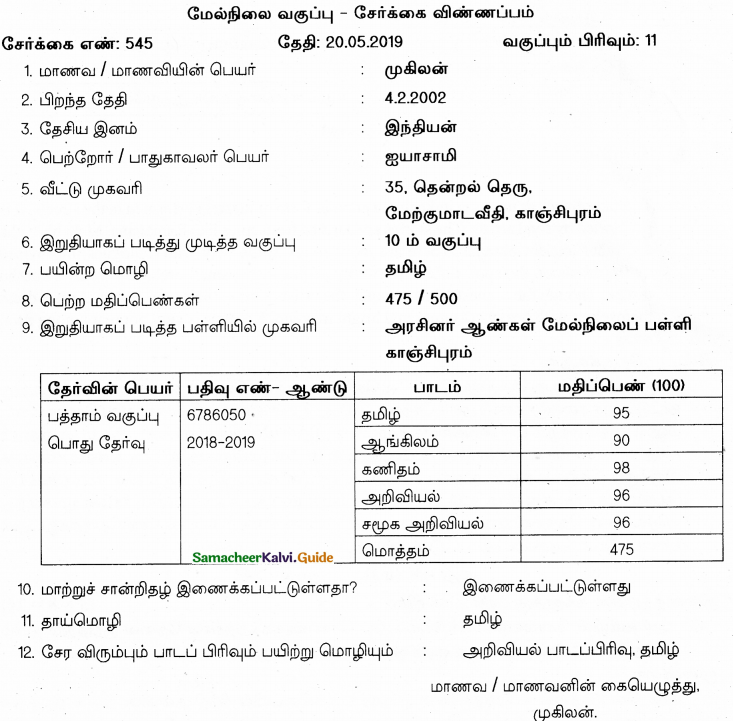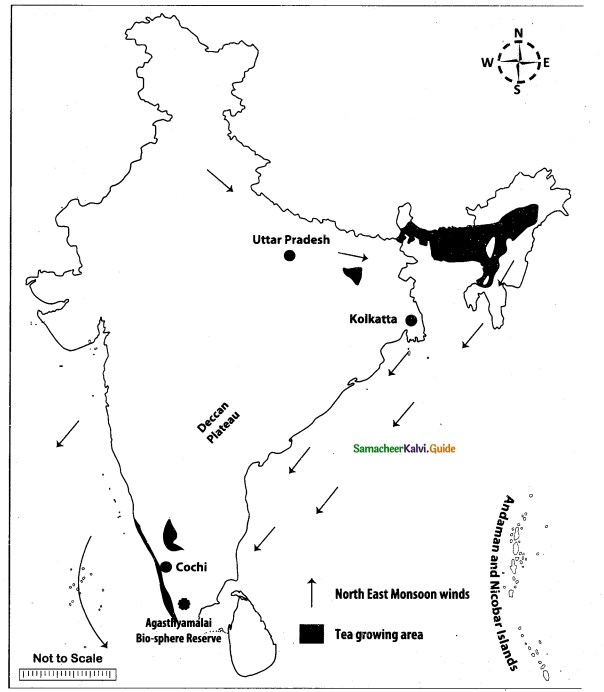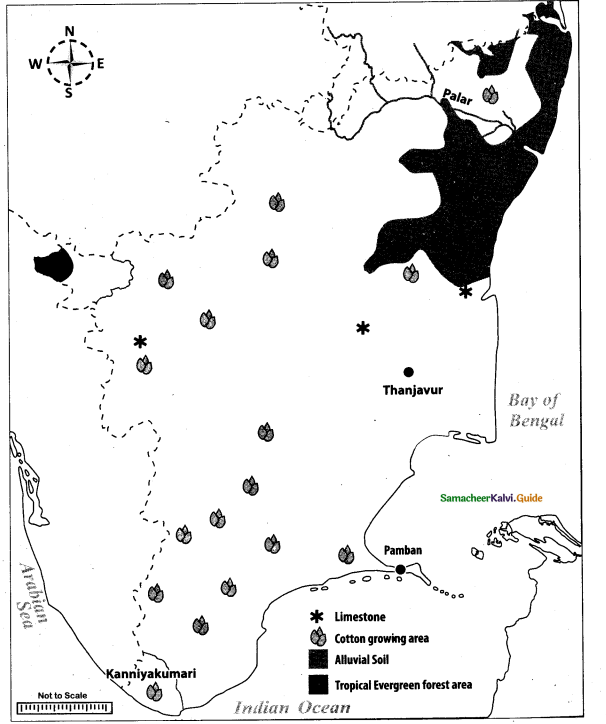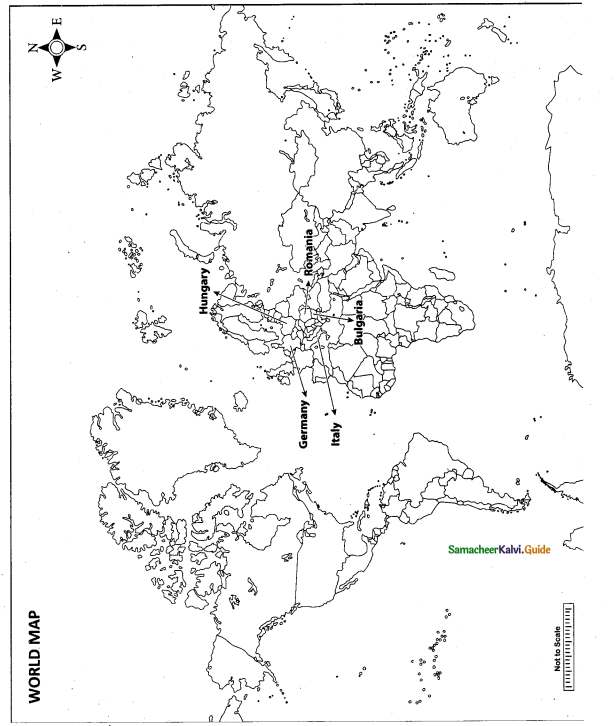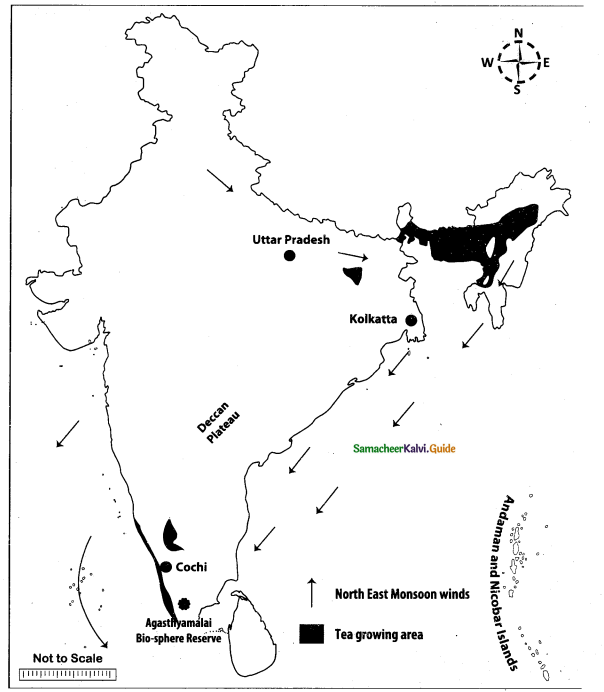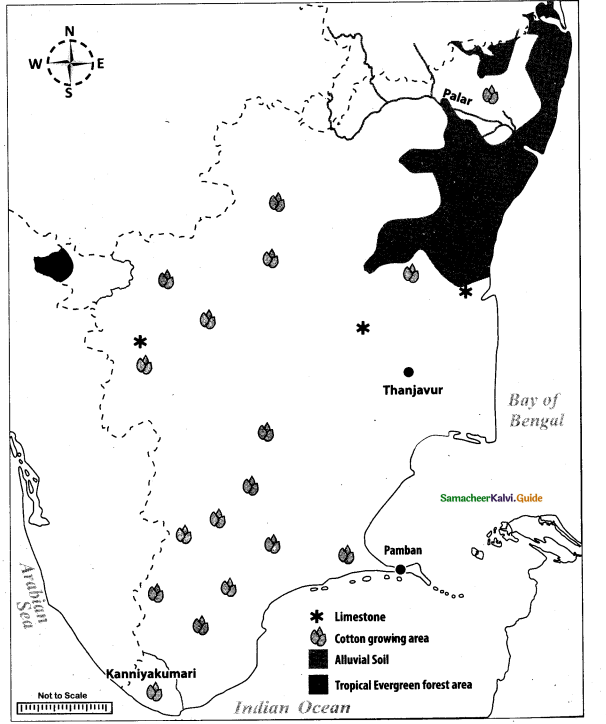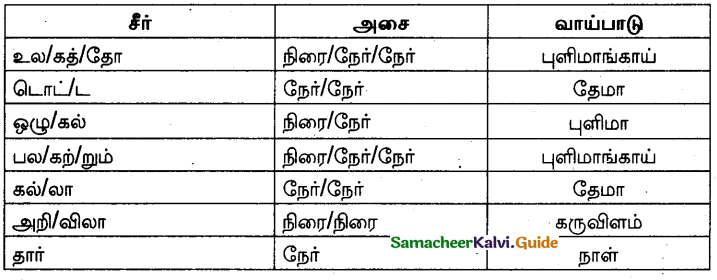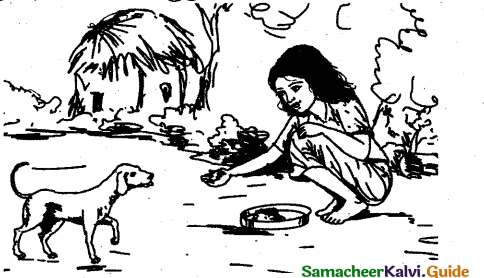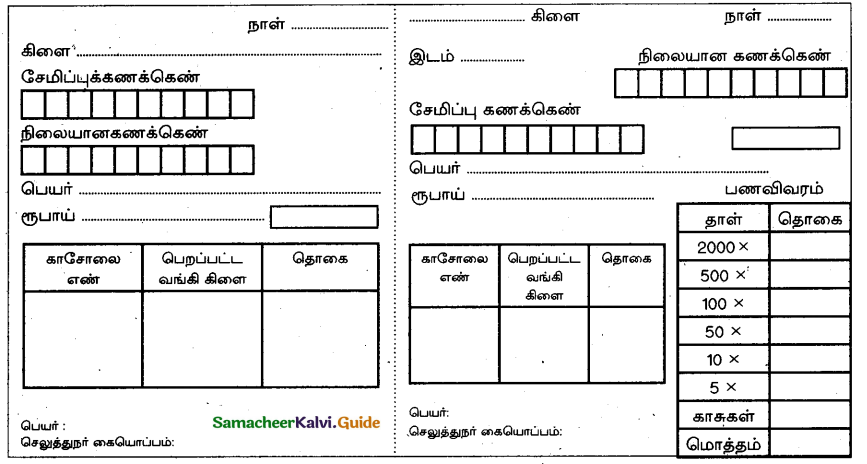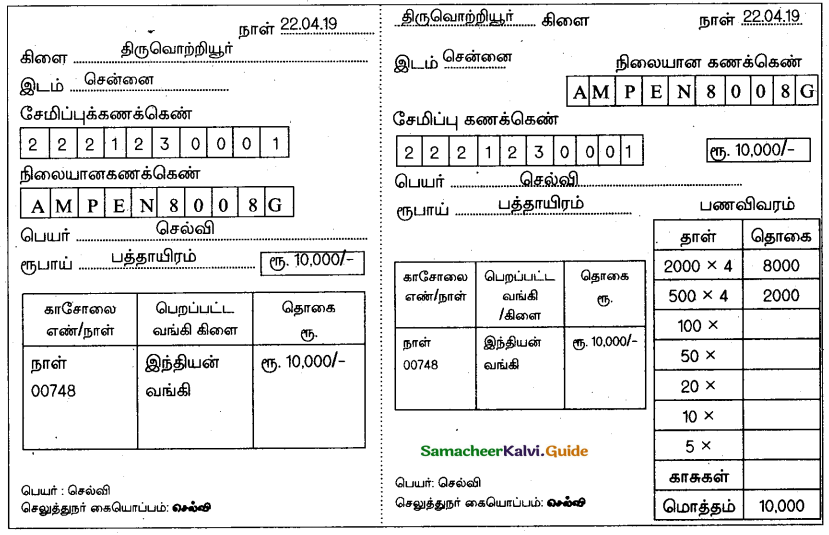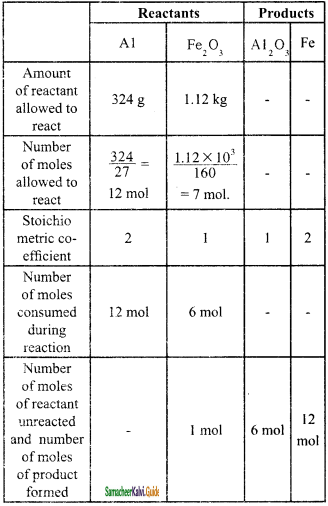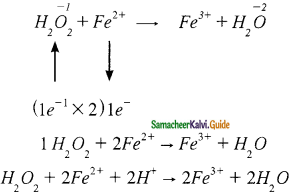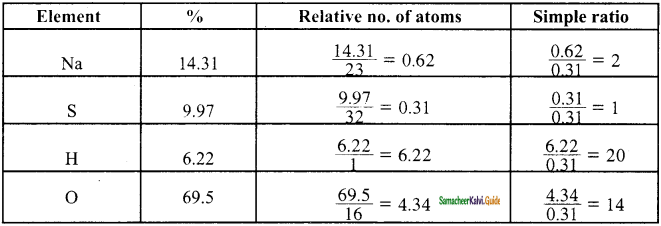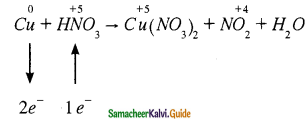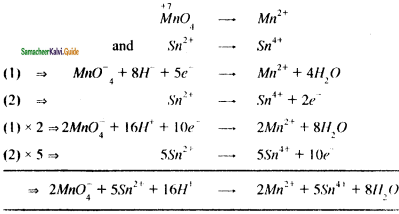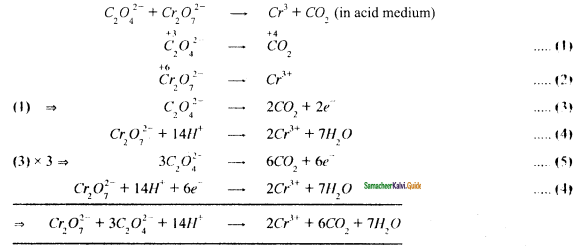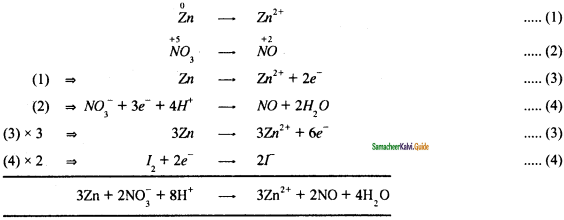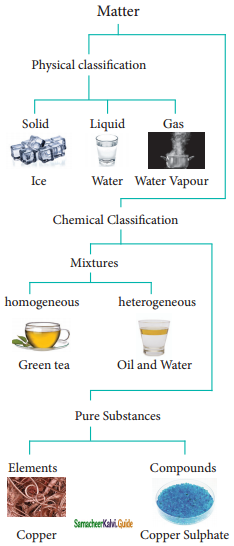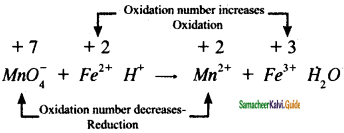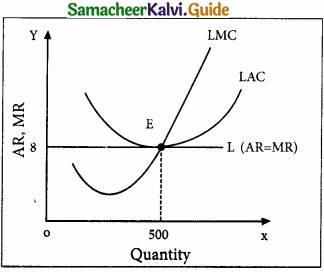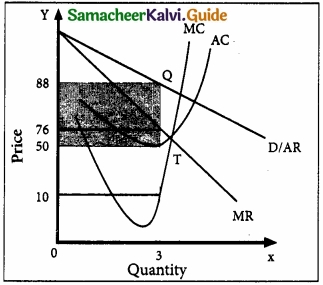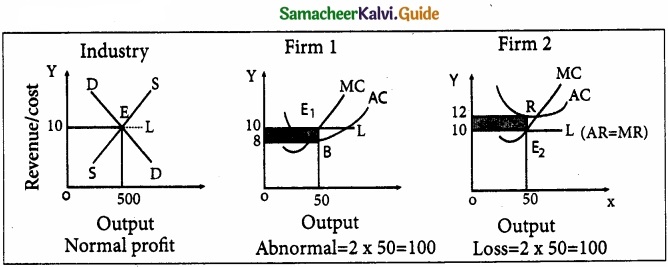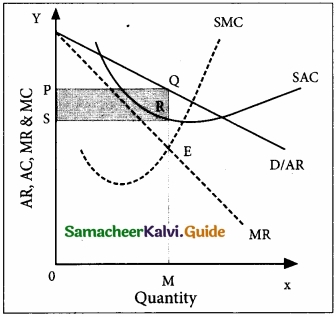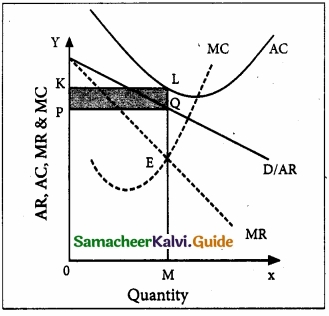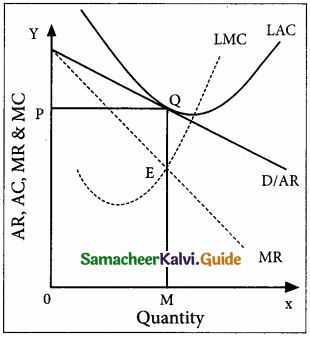Students can Download Samacheer Kalvi 10th Science Model Question Paper 1 English Medium Pdf, Samacheer Kalvi 10th Science Model Question Papers helps you to revise the complete Tamilnadu State Board New Syllabus, helps students complete homework assignments and to score high marks in board exams.
Tamil Nadu Samacheer Kalvi 10th Science Model Question Paper 1 English Medium
General Instructions:
- The question paper comprises of four parts
- You are to attempt all the questions in each part. An internal choice of questions is provided wherever applicable.
- All questions of Part I, II, III and IV are to be attempted separately.
- Question numbers 1 to 12 in Part I are Multiple Choice Questions of one mark each.
These are to be answered by writing the correct answer along with the corresponding option code. - Question numbers 13 to 22 in Part II are of two marks each. Any one question should be answered compulsorily.
- Question numbers 23 to 32 in Part III are of four marks each. Any one question should be answered compulsorily.
- Question numbers 33 to 35 in Part IV are of seven marks each. Draw diagrams wherever necessary.
Time: 3 Hours
Maximum Marks: 75
Part – I
(i) Answer all the questions. [12 × 1 = 12]
(ii) Choose the most suitable answer and write the code with the corresponding answer.
Question 1.
Newton’s III law is applicable ________ .
(a) for a body is at rest
(b) for a body in motion
(c) both a and b
(d) only for bodies with equal masses
Answer:
(c) both a and b
Question 2.
SI unit of resistance is ________.
(a) mho
(b) joule
(c) Ohm
(d) Ohm meter
Answer:
(c) Ohm
![]()
Question 3.
Which of the following is the heaviest one?
(a) Hydrogen
(b) Alpha
(c) Beta
(d) Gamma
Answer:
(b) Alpha
Question 4.
1 mole of any substance contains ________ molecules.
(a) 6.023 × 1023
(b) 6.023 × 10-23
(c) 3.0115 × 1023
(d) 12.046 × 1023
Answer:
(a) 6.023 × 1023
Question 5.
In the alumino thermic process the role of Al is ________
(a) Oxidizing agent
(b) reducing agent
(c) hydrogeneration agent
(d) Sulphurising agent
Answer:
(b) reducing agent
Question 6.
Solubility is the amount of solid dissolved in ________ g of solvent.
(a) 10 g
(b) 50 g
(c) 100 g
(d) 1 g
Answer:
(c) 100 g
![]()
Question 7.
Heart of heart is called ________.
(a) SA node
(b) Purkinjee fibres
(c) AV node
(d) Bundle of His
Answer:
(a) SA node
Question 8.
Metastasis is associated with ________.
(a) Benign tumour
(b) Malignant tumour
(c) Both (a) and (b)
(d) Crown gall tumour
Answer:
(b) Malignant tumour
Question 9.
Kreb’s cycle takes place in ________.
(a) Chloroplast
(b) Stomata
(c) Inner mitochondrial membrane
(d) Mitochondrial matrix
Answer:
(d) Mitochondrial matrix
Question 10.
The endarch condition is the characteristic feature of ________.
(a) root
(b) stem
(c) leaves
(d) flower
Answer:
(b) stem
![]()
Question 11.
Palaeontology deals with the study of ________.
(a) fossils
(b) genes
(c) petroleum
(d) homologous organ
Answer:
(a) fossils
Question 12.
Which software is used to create animation?
(a) Paint
(b) PDF
(c) MS word
(d) Scratch
Answer:
(d) Scratch
Part – II
Answer any seven questions. (Q.No: 22 is compulsory) [7 × 2 = 14]
Question 13.
State the principle of Moments.
Answer:
When a number of like or unlike parallel forces act on a rigid body and the body is in equilibrium, then the algebraic sum of the moments in the clockwise direction is equal to the algebraic sum of the moments in the anti-clockwise direction.
![]()
Question 14.
Why does the sky appear in blue colour?
Answer:
When sunlight passes through the atmosphere, the blue colour is scattered to a greater extent than the red colour. This scattering causes the sky to appear in blue colour.
Question 15.
What is the audible range of frequency?
Answer:
Audible waves – These are sound waves with a frequency ranging between 20 Hz to 20,000 Hz.
Question 16.
What is meant by binary solution?
Answer:
A solution must at least be consisting of two components. Such solutions which are made of one solute and one solvent are called binary solutions, (e.g.) adding CuSO4 crystals to water.
Question 17.
Differentiate reversible and irreversible reactions.
Answer:
Reversible Reaction:
- Reaction can be reversed.
- It proceeds in both directions.
- It attains equilibrium.
- It is relatively slow.
Irreversible Reaction:
- Reaction cannot be reversed.
- It is unidirectional.
- Equilibrium is not attained.
- It is fast.
![]()
Question 18.
What are viviparous animals?
Answer:
The animals which give birth to young ones are called viviparous animals.
Question 19.
Bring out any two physiological activities of abscisic acid (ABA).
Answer:
- ABA promotes the process of abscission. (Separation of leaves, flowers and fruits from the branch)
- During water stress and drought conditions ABA causes stomatal closure.
Question 20.
Define triple fusion.
Answer:
The fusion involving two polar nucleus and a sperm nucleus, that occurs in double fertilization in a seed plant and results in the formation of endosperm is called the triple fusion.
Question 21.
Why is Archaeopteryx considered to be connecting link?
Answer:
Archaeopteryx is the oldest known fossil bird. It is considered to be a connecting link between reptiles and birds. It had wings with feathers like a bird. It had long tail, clawed digits and conical teeth, like a reptile.
![]()
Question 22.
Calculate the resistance of a conductor through which a current of 5A passes, when the potential difference between its ends is 60V.
Answer:
Given, I = 5A
V = 60 V
From Ohm’s law: R = \(\frac{V}{I}=\frac{60}{5}\) =12 Ω
∴ R = 12 Ω
Part – III
Answer any seven questions (Q.No: 32 is compulsory) [7 × 4 = 28]
Question 23.
State the universal law of gravitation and derive its Mathematical expression.
Answer:

This law states that every particle of matter in this universe attracts every other particle with a force. This force is directly proportional to the product of their masses and inversely proportional to the square of the distance between the centres of there masses. The direction of the force acts along the line joining the masses.
Force between the masses is always attractive and it does not depend on the medium where they are placed. Let m1 and m2 be the masses of two bodies A and B placed r metre apart in space
Force, F ∝ m1 × m2, F ∝ \(\frac{1}{r^{2}}\)
On combining the above two expressions,
F ∝ \(\frac{m_{1} \times m_{2}}{r^{2}}\)
F = \(\frac{G m_{1} m_{2}}{r^{2}}\)
Where G is the universal gravitational constant. Its value in SI unit is 6.674 × 10-11 N m2 kg-2.
![]()
Question 24.
(i) List any five properties of light.
Answer:
- Light is a form of energy.
- Light always travel along a straight line.
- Light does not need any medium for its propagation. It can even travel through vacuum.
- The speed of light in vacuum or air is C = 3 x 108 ms-1
- Different coloured light has different wavelength and frequency.
(ii) State Rayleigh’s law of scattering.
Answer:
Rayleigh’s scattering law states that “The amount of scattering of light is inversely proportional to the fourth power of its wavelength”.
Amount of scattering S ∝ \(\frac{1}{\lambda^{4}}\)
Question 25.
(i) A torch bulb is rated at 3V and 600 mA. calculate it’s (a) power (b) resistance (c) energy consumed if it is used for 4 hours.
Answer:
Given
V = 3V
I = 600 mA = 600 × 10-3 A
(a) Power (P) = VI = 3 × 600 × 10-3 = 1800 × 10-3
P= 1.8 W (or) watt.
(b) Resistance (R) = \(\frac{V}{I}\)

R = 5 Ω
(c) Power (P) = 1.8 W and t = 4 hours
= 4 × 60 × 60 = 14400 second.
Energy consumed (E) = P × t
= 1.8 × 14400 = 25920 joules
E = 25.9 Wh
(ii) Why does sound travel faster on a rainy day than on a dry day?
Answer:
When humidity increases the speed of sound increases. That is why we can hear sound from long distances clearly during rainy season.
![]()
Question 26.
Give the salient features of “Modern atomic theory”.
Answer:
The Salient features of “Modern atomic theory” are:
- An atom is no longer indivisible.
- Atoms of the same element may have different atomic masses.
- Atoms of different elements may have same atomic masses.
- Atoms of one element can be transmuted into atom of other elements. In other words, atom is no longer indestructible.
- Atoms may not always combine in a simple whole number ratio.
- Atom is the smallest particle that takes part in a chemical reaction.
- The mass of an atom can be converted into energy E = mc2.
Question 27.
How is Aluminium extracted from Bauxite?
Answer:
Bauxite is the chief ore of aluminium. The extraction of aluminium from bauxite involves two steps:
(1) Conversion of bauxite into alumina – Baeyer’s process.
The conversion of Bauxite into Alumina involves the following steps:
Bauxite ore is finely ground and heated under pressure with a solution of concentrated caustic soda at 150° C to obtain sodium meta aluminate.
On diluting sodium meta aluminate with water, a precipitate of aluminium hydroxide is formed. The precipitate is filtered, washed, dried and ignited at 1000°C to get alumina.
(2) Electrolytic reduction of alumina – Hall’s process.
Aluminium is produced by the electrolytic reduction of fused alumina (Al2O3) in the electrolytic cell.
Cathode: Iron tank linked with graphite
Anode: A bunch of graphite rods suspended in molten electrolyte.
Electrolyte:

Pure alumina + molten cryolite + fluorspar
![]()
Temperature: 900 – 950° C
Voltage used: 5 – 6 V
Overall reaction:
2 Al2O3 → 4 Al + 3 O2 ↑
Question 28.
What are the structures involved in the protection of brain?
Answer:
The brain, controlling centre of all the body activities is covered by three connective tissue membrane (or) meninges.
- Duramater – is the outermost thick fibrous membrane.
- Arachnoid membrane – is the middle thin vascular membrane providing web-like cushion.
- Piamater – is the innermost thin delicate membrane richly supplied with blood. Meningeal membranes protect the brain from mechanical injury.
![]()
Question 29.
(a) Why did Mendel select pea plant for his experiment?
Answer:
- The pea plant is self pollinating and so it is very easy to raise pure breeding individuals.
- It has a short life span.
- It is easy to cross pollinate.
- It has deeply defined contrasting characters.
- The flowers are bisexual.
(b) What is the importance of valves in the heart?
Answer:
The valves are the muscular flaps, that regulate the flow of blood in a single direction and prevent backward flow of blood.
Question 30.
Differentiate the following:
(i) Light dependent reaction and Light independent reaction
Answer:
Light dependent reaction:
- It is called Hill reaction or Light reaction.
- The reaction is earned out in Thylakoid membranes of the chloroplast.
- It is carried out in the presence of light.
- Photosynthetic pigments absorb the light energy and convert it into chemical energy ATP and NADPH2.
Light independent reaction:
- It is called Dark reaction or Biosynthetic pathway or Calvin cycle.
- This reaction is carried out in the stroma of the chloroplast.
- It is carried out in the absence of light.
- CO2 is reduced into carbohydrates with the help of light generated ATP and NADPH2.
(ii) Aerobic and Anaerobic respiration
Answer:
Aerobic:
- Occur in the presence of oxygen.
- Carbon dioxide, water and ATP are produced.
Anaerobic:
- Occur in the absence of oxygen.
- Lactic acid, Ethanol and ATP are produced.
![]()
Question 31.
(a) What is metastasis?
Answer:
The cancerous cells migrate to distant parts of the body and affect new tissues and this process is called Metastasis.
(b) What are the effects of hybrid vigour in animals?
Answer:
The superiority of the hybrid, obtained by cross breeding is called heterosis or hybrid vigour.
Effects of hybrid vigour:
- Increased production of milk by cattles.
- Increased production of egg by poultry.
- High quality of milk is produced.
- Increased growth rate in domesticated animals.
Question 32.
(i) Explain Soddy and Fajan Radioactive displacement law.
Answer:
Alpha decay:
(a) Unstable parent nucleus emits an alpha particle to form stable daughter nucleus.
(b) 92U238 → 90Th234 + 2He4 ( α – decay ).
(c) Mass number decreases by 4.
(d) Atomic number decreases by 2.
Beta decay:
(a) Unstable parent nucleus emits a beta particle to form stable daughter nucleus.
(b) 15P32 → 16S32 + -1e0 (β – decay)
(c) Mass number – no change.
(d) Atomic number increased by 1.
Gamma decay:
(a) The atomic number and the mass number remain same.
(b) The energy level of the nucleus change. .
(ii) Calculate the pH of 0.05M H2SO4.
[H+] = Normality = Molarity × basicity
= 0.05 × 2 = 0.1
= 10-1 = 1 × 10-1
pH = -log10 [H+]
pH = -log10 1 × 10-1
pH = -log10 1 – log 10-1
pH = 0 – (- 1 log10 10) = 1
Part – IV
Answer all the questions. [3 × 7 = 21]
Question 33.
(a) (i) State the law of volume.
Answer:
When the pressure of gas is kept constant, the volume of a gas is directly proportional to the temperature of the gas.
(i.e.,) V ∝ T .
\(\frac{V}{T}\) = constant
(ii) Derive the ideal gas equation.
Answer:
The ideal gas equation is an equation, which relates all the properties of an ideal gas. An ideal gas obeys Boyle’s law, Charles’ law and Avagadro’s law,
According to Boyle’s law
PV = constant ……… (1)
According to Charles’s law,
\(\frac{V}{T}\) = constant …….(2)
According to Avagadro’s law,
\(\frac{V}{n}\) = constant ……(3)
After combining equations (1), (2) and (3)
\(\frac{P V}{n T}\) = constant ……..(4)
The above relation is called combined law of gases. If you consider a gas, which contains μ moles of the gas, the number of atoms contained will be equal to (i times the Avagadro’s number, NA
(i.e.,) n = μ NA
using equation (5) equation (4) can be written as
PV / μ NA T = constant
The value of the constant in the above equation is taken to be kB, which is called as Boltzmann constant (1.38 × 10-23 J K-1). Hence, we have the following equation,
PV / μ NA T = kB
PV = μ NA kB T
Here μ NA kB = R, which is termed as universal gas constant whose value is 8.31 Jmol-1_1K-1
PV = RT
Ideal gas equation is also called as equation of state because it gives the relation between the state variables and it is used to describe the state of any gas.
[OR]
(b) (i) A man is standing between two vertical walls 680 m apart. He claps his hands and hears two distinct echoes after 0.9 seconds and 1.1 seconds respectively. What is the speed of sound in the air?
Answer:

(ii) A door is pushed, at a point whose distance from the hinges is 90 cm, with a force of 40 N. Calculate the moment of the force about the hinges.
Answer:
The moment of a force M = F × d
F = 40 N
d = 90 cm = 0.9 m
Hence, moment of the force = 40 × 0.9 = 36 Nm
![]()
Question 34.
(a) (i) Calculate the mass of 2.5 mole of oxygen atom.
Answer:
Number of moles = \(\frac{\text { Mass }}{\text { Atomic mass }}\)
∴ Mass = Number of moles × Atomic mass
= 0.5 × 16 = 8 g
(ii) Calculate the number of molecules in 11g of CO2.
Answer:
Gram Molecular of CO2 = 44 g.
number of molecules in 44 g of CO2 = 6.023 × 1023
number of molecules in 11 g of CO2 = \(\frac{6.023 \times 10^{23}}{44}\) × 11
= 1.53 × 1023 molecules
(iii) Calculate the number of moles in 81g of aluminium.
Answer:
Number of moles = \(\frac{\text { Mass }}{\text { Atomic mass }}\)
= \(\frac{81}{27}\) = 3 moles
[OR]
(b) How is ethanol manufactured from sugar-cane?
Answer:
Molasses is a dark coloured syrupy liquid left after the crystallization of sugar from the concentrated sugarcane juice. It contains 30 % of Sucrose, which cannot be separated by crystallization.
(i) Dilution of Molasses:
Molasses is first diluted with water,to bring down the concentration of sugar to about 8 to 10 percent.
(ii) Addition of Nitrogen Source:
Molasses contains enough nitrogenous matter to act as food for yeast during the fermentation process. If the nitrogenous matter is poor, ammonium sulphate or ammonium phosphate is added.
(iii) Addition of yeast:
This solution kept in large fermentation tank and yeast is added to it kept at about 303K for a few days. During this period, the enzymes invertase and Zymase present in yeast, convert sucrose into ethanol.

The fermented liquid is technically called wash.
(iv) Distillation of wash:
This wash containing 15 to 18% alcohol, is now subjected to fractional distillation. The main fraction drawn is an aqueous solution of ethanol which contains 95.5% of ethanol and 4.5% of water. This is called rectified spirit. This mixture is then refluxed over quicklime for about 5 to 6 hour and then allowed to stand for 12 hours. On distillation of mixture pure alcohol (100%) is obtained. This is called absolute alcohol.
![]()
Question 35.
(a) (i) Which hormone requires iodine for its formation? What will happen if intake of iodine in our diet is low?
Answer:
The formation of Thyroxine (T4) and Triiodothyronine requires iodine. If there is an inadequate supply of iodine in our diet it leads to enlargement of thyroid gland called goitre.
(ii) What is the importance of rainwater harvesting?
Answer:
The importance of rainwater harvesting is as follows:
- Overcome the rapid depletion of ground water level.
- To meet the increased demand of water.
- Reduces flood and soil erosion.
- Water stored in ground is not contaminated by human and animal wastes and hence can be used for drinking purposes.
(iii) What is colostrum? How is milk production hormonally regulated?
Answer:
The first fluid which is produced from the mammary gland after child birth is called colostrum. Milk production from alveoli of mammary gland is stimulated by prolactin secreted from anterior pituitary.
[OR]
(b) (i) How does locomotion take place in leech?
Answer:
Locomotion in leech takes place by:
- Looping or crawling movement: Crawling movement is brought about by the contraction and relaxation of muscles. The two suckers serve for attachment during movement.
- Swimming movement: Leeches swim very actively and perform undulating movement in water.
(ii) How does Fossilization occur in plants?
Answer:
Fossilization in plants: The process of formation of fossil in the rocks is called fossilization.
The common methods of fossilization includes:
1. Petrifiction: Minerals like silica slowly penetrate in and replace the original organic tissue. This method can preserve hard and soft parts, (e.g.) wood fossils.
2. Mold and Cast: A replica of a plant or animal is preserved in sedimentary rocks. When the organism get buried in sediment it is dissolved by underground water leaving a hollow depression called Mold. It shows only the original shape and not the internal structure. Minerals or sediments fill the hollow depression and forms a cast.
3. Preservation: The entire plant may be preserved to protect from the organism from decay. Ice or amber (tree sap) can be used for preservation.
4. Compression: When the organism dies, the hard parts settle at the bottom of the sea bed and are covered by sediment. The process goes on continuously and the fossils are formed.
5. Infiltration: The precipitation of minerals takes place which later on infiltrate the cell wall. The process is brought about by several mineral element such as silica, calcium carbonate and magnesium carbonate.




